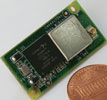

Connect One has released Nano WiReach, an embedded WiFi bridge that connects any embedded device to 802.11b/g wireless LANs with minimal programming. Measuring only 1,7 x 3,3 centimetres, the module’s multiple hardware interfaces and extensive firmware functionality make it a highly advanced and versatile WiFi solution for embedded devices.
Based on Connect One’s iChipSec CO2144 IP controller chip, Nano WiReach includes a full suite of Internet protocols and applications, enabling full–featured connectivity for embedded solutions without any WiFi driver development or porting.
WiReach’s firmware supports several modes of operation:
LAN to WiFi Bridge – allows transparent bridging of LAN over WiFi using direct RMII connection to existing MAC hardware. Any microcontroller with a built-in Ethernet MAC can be connected to WiFi with minimal development effort.
* Serial to WiFi Bridge – enables transparent bridging of serial data over WiFi using the module’s 3 Mbps UART.
* Full Internet Controller mode – allows simple microcontrollers to use the WiReach’s protocol and application capabilities to perform complex Internet operations such as e-mail, FTP, SSL, embedded web server and others. Internet controller mode can be used with any hardware interface.
* Embedded IP Routing – allows multiple WiFi clients to use a single WAN connection to the Internet, using the WiReach as a router.
* PPP emulation – offers existing (eg, cellular modem) designs currently using PPP to interface to the cellular modem by connecting transparently over WiFi with no changes to application or drivers.
Nano WiReach includes RMII, USB, SPI and fast UART interfaces for integration into existing or new designs. It is available in two versions – one with an antenna connector and one with a built-in antenna. It includes the latest WiFi encryption algorithms (WPA/WPA2, in both PSK and enterprise modes) and Internet SSL encryption algorithms. In addition, it serves as an inherent firewall, protecting the embedded application from attacks originating from the Internet.
Designers do not need to port/write WiFi drivers or significantly reprogram their applications to connect to WiFi using the Nano WiReach. In Internet Controller mode, the module is driven by simple text commands and offloads the WiFi drivers, WPA supplicant, Internet security, networking protocols and all communication tasks from the host microcontroller and application. Since WiReach’s firmware is remotely updateable, new security or connectivity protocols do not require application redesign, increased memory or faster processor speeds.
Nano WiReach supports 10 simultaneous TCP/UDP sockets; two listening TCP sockets; SMTP, MIME, POP3, FTP, Telnet and HTTP/HTTPS clients; an HTTP/HTTPS embedded Web server with a website for the host application and one for configuring the module. It also supports 64/128 bit WEP, WPA/WPA2 (PSK and Enterprise) encryption, AES-128/256, SHA-128/192/256, 3DES; the SSL3/TLS1 protocol for a secure client socket session and a secure FTP session.
| Tel: | +27 21 555 8400 |
| Email: | [email protected] |
| www: | www.rfdesign.co.za |
| Articles: | More information and articles about RF Design |

© Technews Publishing (Pty) Ltd | All Rights Reserved